A Baltimore Oriole caught the eye of a birdwatcher as the sun shone through the trees. Its bright orange feathers stood out against the greenery. This moment showed how offering oranges can bring joy to many birds.
Many bird species love oranges, from tropical to temperate areas. They enjoy the sweet, juicy flesh. What birds like oranges?, fruit-eating birds, orange-loving avians, citrus-enjoying species, tropical fruit birds, and exotic bird diets all find oranges tasty.
Key Takeaways
- Orioles are the primary birds attracted to oranges due to their bright colors.
- Spring is the best time to offer oranges to birds, particularly for attracting orioles.
- Feeding birds oranges is a low-maintenance activity, as simple as hanging an orange half.
- Other fruits that birds enjoy include apple halves, grapes, bananas, and melons.
- Orioles are likely to stick around if they find a good feeding spot, especially during nesting season.
Orioles: The Citrus-Loving Avians
Bullock’s orioles, Baltimore orioles, and orchard orioles are three fascinating bird species. They brighten North American backyards with their vibrant colors and love for citrus fruits. These birds are a treat for birdwatchers, known for their striking appearance and fun feeding habits.
Bullock’s Orioles and Their Vibrant Plumage
Bullock’s orioles are famous in the western United States for their bright orange and black feathers. These birds often visit feeders, looking for sweet nectar and juicy orange slices. Their bright colors and agile moves make them a joy to watch in any garden.
Baltimore Orioles and the East Coast Delight
On the East Coast, the Baltimore oriole is a favorite. These birds, with their unique orange and black feathers, also love citrus fruits. Homeowners look forward to their spring return, ready to share their favorite treats.
Orchard Orioles: The Hybrid Surprise
The orchard oriole, possibly a hybrid of Bullock’s and Baltimore orioles, may also visit orange feeders. With their olive-green and chestnut feathers, they bring a special touch to the oriole family. This adds to the variety of these citrus-loving birds.
Orioles migrate back to North America in spring, seeking nectar, insects, and ripe fruits. Their preference for oranges and other citrus makes them popular at backyard feeders. Birdwatchers enjoy their bright colors and interesting behaviors.
Tanagers: A Tropical Splash of Color
Tanagers bring a burst of color to your backyard with their vibrant feathers. The western tanager, found in the western United States, was the first to make bird lovers offer oranges. These tropical birds love the sweet citrus and often hang out with orioles and other fruit-eaters.
Western Tanagers: The Story That Started It All
Western tanagers stand out with their bright yellow bodies, black wings, and red heads. They make a long migration each year from Mexico and Central America to the western United States and Canada. This journey is quite a sight.
When they arrive, they’re drawn to oranges. Homeowners who put out orange slices or segments might see these tanagers and other birds enjoying the feast.
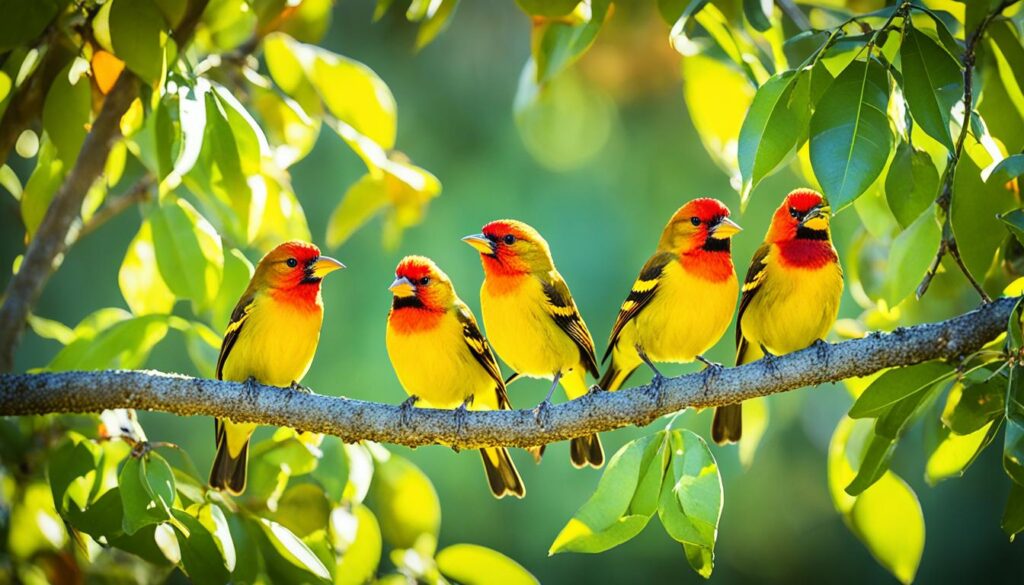
“The western tanager’s arrival in my backyard was a true harbinger of spring, signaling the beginning of a new season of avian activity and a chance to observe these beautiful creatures up close.”
Learning about the tanagers’ feeding habits and their place in nature can deepen your love for these birds.
Lazuli Buntings: A Surprising Visitor
The lazuli buntings are not usually seen eating fruit. Yet, they sometimes visit unusual bird feeders for unexpected citrus visitors. The author was thrilled to see these beautiful blue birds enjoying the juicy orange pulp. They usually eat millet and other seeds.
Lazuli buntings migrate from the western United States and parts of Canada to Mexico for the winter. These birds stand out with their bright blue feathers and orange chests. Seeing them at backyard feeders is a rare treat for bird lovers.
“The appearance of lazuli buntings at an orange feeder can be a delightful surprise for backyard bird enthusiasts.”
It’s not clear why lazuli buntings sometimes eat citrus fruits. But their visits to unusual bird feeders are a chance to see the variety of birds around us. Watching for these unexpected citrus visitors can make birdwatching more exciting.
House Finches: The Frequent Flyers
The house finches are often seen at backyard orange feeders. They love the sweet citrus and teach their young to enjoy it too. During summer, families of house finches gather at the feeders, showing their love for this treat.
House finches visit the feeder almost daily, enjoying their meals. The Backyard Bird Book says they might be the most common visitors. These adaptable birds are a joy to see, with their bright colors and family feedings.
“House finches may become the most frequent visitors to bird feeders.”
It took time to tell house finches apart from purple and Cassin’s finches. They look quite similar. Diet affects their color, showing a link between what they eat and how they look.
Studies show that male house finches can have yellow, orange, or red colors. This is true for all house finches, thanks to genetics.
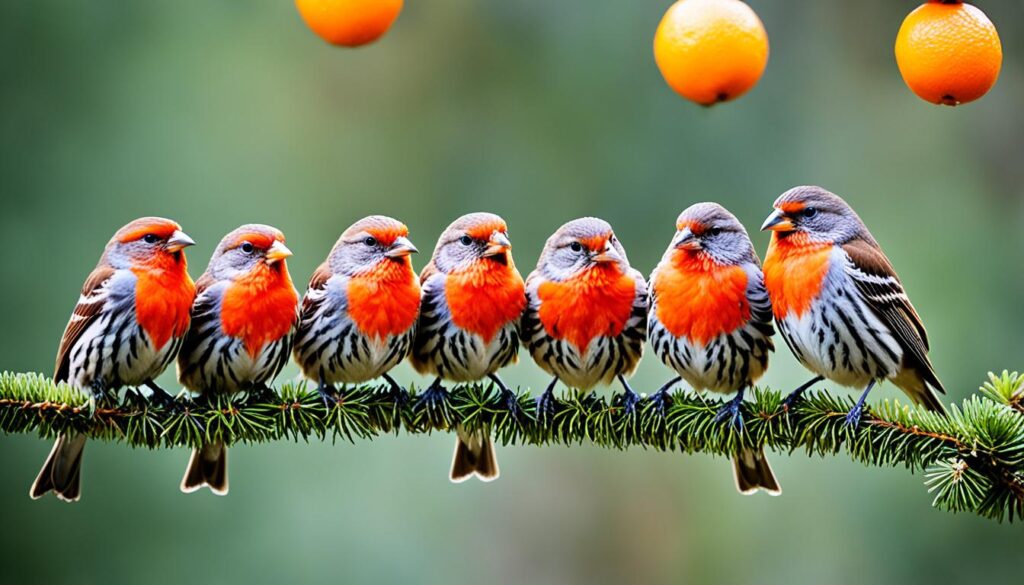
House finches are a favorite in many yards. They offer a peek into the lives of these frequent orange visitors and their family feedings. Their bright colors and love for orange feeders make them a joy for bird lovers.
Grosbeaks: The Chunky-Beaked Fruit Lovers
Grosbeaks have thick beaks that make them perfect for eating oranges. Black-headed grosbeaks are common in the western United States. They like oranges but prefer bird seed too. Rose-breasted grosbeaks are in the east and also enjoy oranges and other fruits.
Black-Headed Grosbeaks: A Western Delight
In the mountain west of Wyoming, many birds like to eat oranges. Black-headed grosbeaks are bright and visit orange feeders often. They come from late May to July.
Rose-Breasted Grosbeaks: A Potential Guest
Rose-breasted grosbeaks live in the eastern United States. They might visit feeding stations with oranges. This can be a fun surprise for bird lovers.
Grosbeaks have chunky beaks great for oranges. Watching them eat can be interesting. It’s a great way to enjoy backyard birding.
“A one-of-a-kind rose-breasted grosbeak and scarlet tanager hybrid was documented in Pennsylvania in 2020, showcasing the fascinating diversity of these frugivorous birds.”
Other Fruit-Loving Birds
While orioles, tanagers, and buntings are famous for visiting orange feeders, others also enjoy citrus treats. Catbirds, thrashers, and woodpeckers often come to taste the oranges too.
Catbirds and Thrashers: The Thicket Dwellers
Catbirds and thrashers love the thickets and tree belts. They sometimes come to backyard feeders for oranges. These birds are fun to see as they eat the fruit.
Woodpeckers: The Unexpected Citrus Fans
Woodpeckers, like the red-bellied and downy, also eat oranges. They’re usually busy hunting insects, but they enjoy oranges too.
Seeing catbirds, thrashers, and woodpeckers at orange feeders is exciting for bird lovers. These fruit-eating birds might not visit often, but they show how many birds can be drawn to oranges.
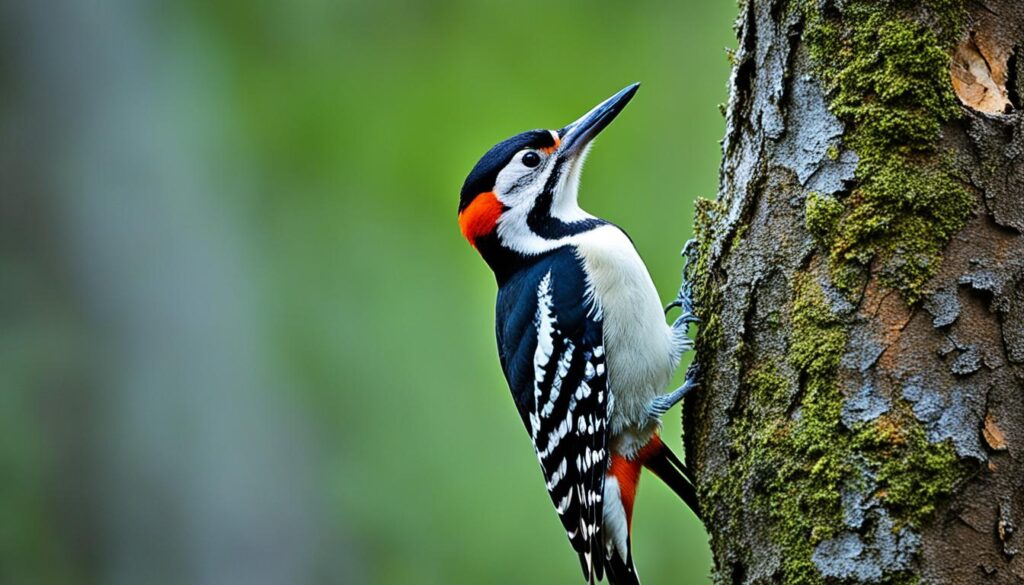
“Attracting a wide variety of birds to your backyard can be as simple as offering a variety of fruits, including oranges. The unexpected guests, like catbirds, thrashers, and woodpeckers, can add an element of delight to your birdwatching experience.”
When to Offer Oranges
The best time to offer oranges to attract birds is in the spring. This is when migratory birds like orioles return to their breeding grounds. Offering oranges at this time ensures a reliable food source for them.
As summer comes, oranges may spoil faster. So, you’ll need to replace them more often.
Orioles love oranges and are quick to find and enjoy them. Oriole migration patterns show the best time to offer oranges is when these birds start to arrive. This is usually in late spring or early summer.
“Over 20 Western tanagers and about 10 Bullock’s orioles were observed feeding on oranges in the backyard. The tanagers and orioles consumed a whole bag of oranges within five days, totaling $8 worth of oranges.”
Other birds like tanagers, mockingbirds, robins, woodpeckers, and grosbeaks also enjoy oranges. By offering oranges at the right time, you’ll attract many birds to your feeder. This lets you enjoy their beautiful colors and songs.
As summer goes on, oranges may spoil faster because of the heat. Keep an eye on the oranges and replace them as needed. This way, you’ll keep your feeder attractive and safe for the birds.
Choosing the Right Feeder
Choosing the right feeder is key when you want to attract fruit-loving birds. You can go for a DIY feeder or buy one. The right feeder design makes the experience better for you and the birds.
DIY Options for Orange Feeders
One easy way to offer DIY orange feeders is to nail halved oranges to a tree or fence post. This lets birds easily get to the oranges. You can also use old saucers or mesh bags to make more complex DIY orange feeders.
Purchased Feeders: A Burst of Color
If you want something more colorful, commercial orange feeders come in many bright designs. These feeder designs attract birds like orioles and tanagers with their colors. Some commercial orange feeders also have perches for easier bird access.
Whether you pick a DIY or a commercial orange feeder, make sure it’s strong, weatherproof, and easy for birds to use. The right feeder makes your bird-feeding station inviting and fun for everyone.
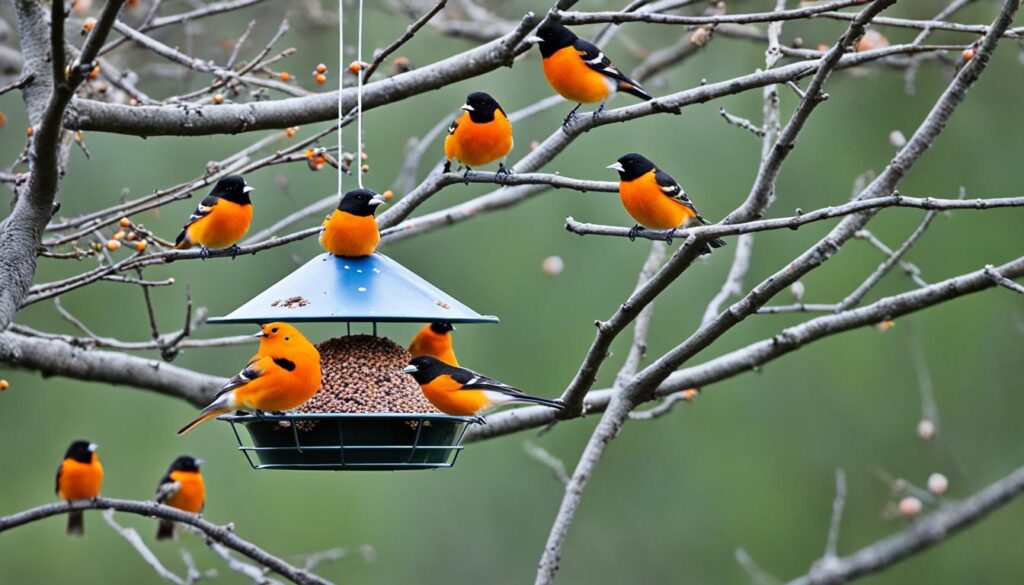
What birds like oranges?
Many birds love oranges, from the bright orioles to the colorful tanagers and happy house finches. These birds brighten up backyard feeders across the U.S. They make bird-watching exciting with their vibrant colors.
Orioles are famous for their love of oranges. They include the Bullock’s orioles, Baltimore orioles, and orchard orioles. These birds enjoy the sweet oranges we offer.
Tanagers like oranges too. The Western tanager is one such bird. They add a touch of the exotic to our backyards.
The lazuli bunting is another bird that loves oranges. These blue birds are a rare but welcome sight at feeders.
Don’t forget the house finches. They are common visitors who enjoy orange slices.
Other birds that might visit for oranges include grosbeaks, catbirds, thrashers, and woodpeckers. Each has its own unique style and way of eating.
Offering oranges is a great way to attract different birds to your yard. It makes bird-watching fun and colorful.
Maintaining a Clean Feeding Station
Keeping your bird feeding station clean is key for your birds’ health and safety. Feeding station maintenance, fruit feeder cleanliness, and food spoilage prevention are vital. They make sure your backyard birds have a steady, nutritious food supply.
Fresh fruit like oranges can go bad fast, especially in the heat. To stop this, check your feeders often and take out any moldy or dry oranges. Put in fresh, clean citrus halves to keep your birds happy and fed.
- Clean your fruit feeders every 3-5 days, especially when it’s hot, to keep them clean.
- Soak the feeders in a 10% bleach solution for at least 15 minutes to kill harmful germs.
- Rinse the feeders well and let them dry before filling them with fresh fruit again.
By being careful and keeping your feeding station clean, you help your backyard birds stay safe and healthy. This easy step stops food spoilage and keeps your birds happy.
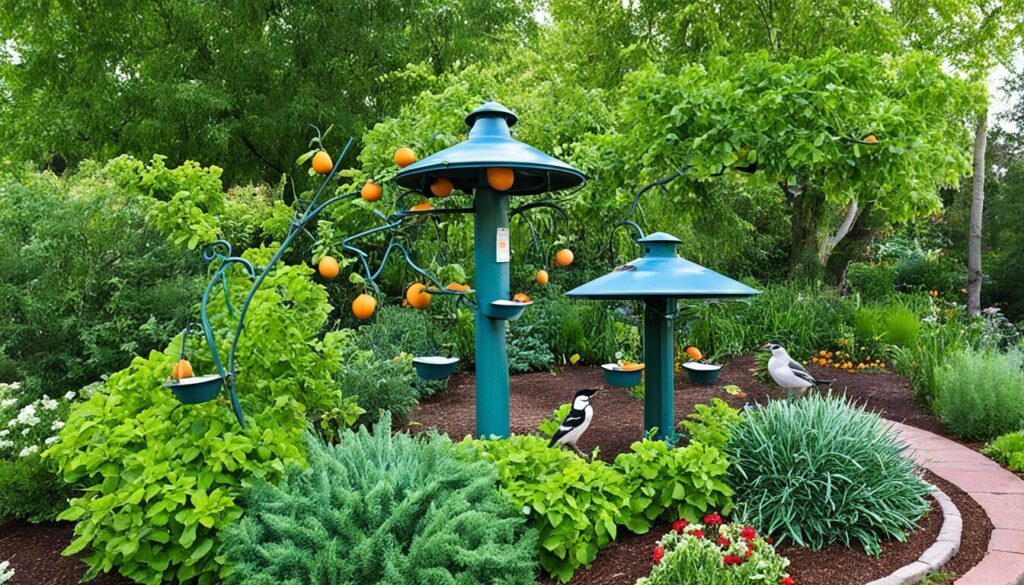
“Proper cleaning and replenishment will ensure that your backyard birds continue to enjoy a reliable and safe source of this sweet citrus treat.”
Diversifying Your Bird Feeding Experience
Offering oranges and other fruits can bring different types of birds to your yard. This variety of food may draw in birds like orioles, tanagers, and grosbeaks that don’t usually visit your feeders. It makes your backyard a lively spot for bird watching.
In the tropics, some lodges feed birds to get a closer look. This has brought tanager species like the western, summer, and scarlet tanagers to backyards. Orioles especially enjoy orange halves. You can also try mealworms, which attract many birds, including bluebirds and robins.
Roasted seeds like pumpkin or squash seeds are great for birds like Northern cardinals and sparrows. Baked eggshells provide calcium, important for female birds in the nesting season. Planting native berries or fruit trees can make your feeding station more diverse and draw in various birds.
Homemade suet mixes with lard, peanut butter, raisins, and birdseed are favorites among bird lovers. Compost piles can also attract birds like black-billed magpies, adding a natural element to your yard.
“Offering a variety of food options can help attract a wider range of bird species to your backyard, making it a more dynamic and engaging place to observe nature.”
By diversifying your bird feeding, you can attract new bird species and expand the backyard visitors you see all year. This makes bird watching more exciting and rewarding.
Conclusion
Oranges are a great food for attracting different kinds of birds to your yard. They attract everything from orioles and tanagers to buntings and finches. By offering oranges, you can make your bird feeder more interesting for these birds.
Oranges are full of vitamins that help birds stay healthy. They also boost the immune system. This makes your yard a better place for birds to visit.
Starting with an orange feeder is easy and fun. You can slice oranges or use a feeder. Just make sure to use fresh, organic oranges and keep the feeder clean.
This way, you can watch many different birds come to your yard. You’ll see their bright colors and interesting behaviors. Adding oranges to your bird feeder is a great way to enjoy nature.
Enjoying orange-loving birds is a great way to connect with nature. Start your own orange bird feeding adventure today. See the unique birds that will visit your backyard.
FAQ
What birds like oranges?
Birds like orioles, tanagers, lazuli buntings, house finches, grosbeaks, catbirds, thrashers, and woodpeckers enjoy oranges.
Which birds are the most popular orange-loving birds?
Orioles are the top birds that love oranges. They are known for their bright colors and love for the fruit.
What types of orioles enjoy oranges?
Bullock’s orioles and Baltimore orioles like oranges. Orchard orioles, a mix of Bullock’s and Baltimore orioles, might also visit feeders.
Which other birds besides orioles like oranges?
Tanagers, like the western tanager, enjoy oranges too. Other birds that like oranges include lazuli buntings, house finches, grosbeaks, catbirds, thrashers, and woodpeckers.
When is the best time to offer oranges to attract birds?
Offer oranges in the spring. This is when migratory birds like orioles come back to breed.
What types of orange feeders are available?
You can use DIY methods like hanging oranges on a tree or fence. Or, you can buy orange feeders that attract fruit-loving birds.
How should I maintain an orange feeding station?
Keep your orange feeders clean by removing moldy or dry oranges. Replace them with fresh ones. This keeps your birds safe and happy.
How can offering oranges diversify the types of birds in my backyard?
Giving oranges and other fruits brings more bird species to your yard. You’ll see orioles, tanagers, and grosbeaks, not just usual seed or suet feeders birds. This makes your backyard more lively and fun to watch.
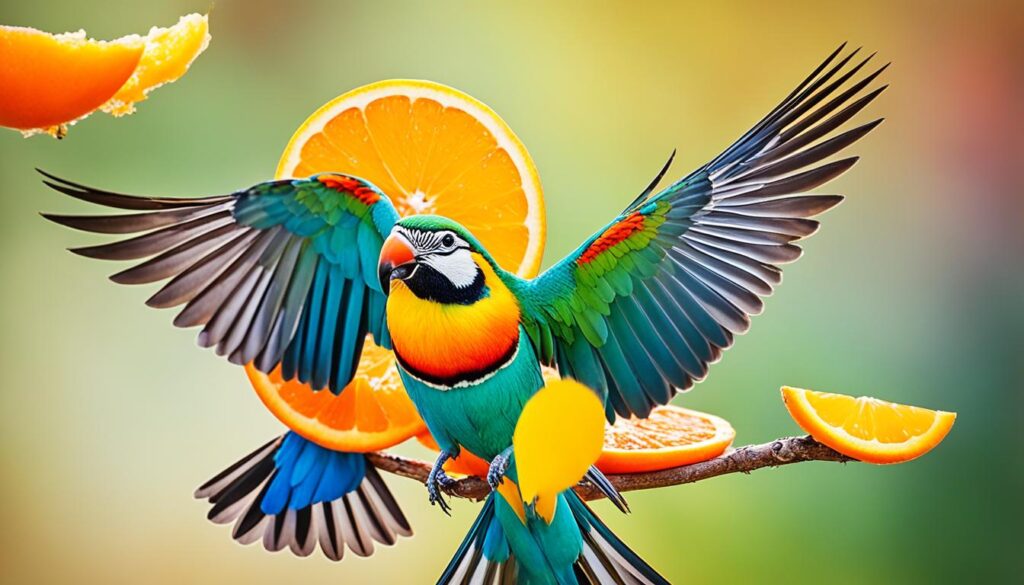

платформа для покупки аккаунтов маркетплейс для реселлеров
купить аккаунт с прокачкой https://marketplace-akkauntov-top.ru
магазин аккаунтов социальных сетей платформа для покупки аккаунтов
купить аккаунт биржа аккаунтов
магазин аккаунтов https://prodat-akkaunt-online.ru
маркетплейс аккаунтов площадка для продажи аккаунтов
услуги по продаже аккаунтов магазин аккаунтов
Account marketplace Account Sale
Marketplace for Ready-Made Accounts https://accountsmarketplacepro.com
Website for Selling Accounts Account Market
Account trading platform Buy Account
Account Market Secure Account Sales
Sell Account Accounts for Sale
Verified Accounts for Sale Buy Pre-made Account
Account Acquisition Database of Accounts for Sale
Account trading platform Database of Accounts for Sale
Accounts market Sell accounts
ready-made accounts for sale sell accounts
sell account bestaccountsstore.com
account exchange social media account marketplace
account catalog website for buying accounts
account trading platform buycheapaccounts.com
accounts for sale account market
account store sell account
account acquisition accounts for sale
marketplace for ready-made accounts account trading
account buying platform social media account marketplace
sell accounts social media account marketplace
account trading social media account marketplace
account market account exchange
accounts marketplace account acquisition
find accounts for sale social media account marketplace
buy accounts buy-social-accounts.org
profitable account sales profitable account sales
database of accounts for sale https://best-social-accounts.org/
account market sell accounts
account exchange service ready-made accounts for sale
account selling service account buying service
gaming account marketplace account acquisition
website for buying accounts sell pre-made account
accounts for sale purchase ready-made accounts
verified accounts for sale account trading platform
purchase ready-made accounts account acquisition
database of accounts for sale online account store
social media account marketplace accounts-offer.org
accounts marketplace https://accounts-marketplace.xyz
account market https://buy-best-accounts.org
account trading platform https://social-accounts-marketplaces.live
social media account marketplace https://accounts-marketplace.live
account acquisition https://social-accounts-marketplace.xyz/
website for selling accounts https://buy-accounts.space
accounts for sale https://buy-accounts-shop.pro/
online account store accounts market
account buying platform https://accounts-marketplace.online/
marketplace for ready-made accounts https://social-accounts-marketplace.live
маркетплейс аккаунтов соцсетей https://akkaunty-na-prodazhu.pro/
продажа аккаунтов rynok-akkauntov.top
площадка для продажи аккаунтов https://kupit-akkaunt.xyz/
продать аккаунт https://akkaunt-magazin.online/
биржа аккаунтов https://akkaunty-market.live/
площадка для продажи аккаунтов kupit-akkaunty-market.xyz
маркетплейс аккаунтов https://akkaunty-optom.live
магазин аккаунтов online-akkaunty-magazin.xyz
продажа аккаунтов akkaunty-dlya-prodazhi.pro
магазин аккаунтов https://kupit-akkaunt.online/
buy facebook ads manager https://buy-adsaccounts.work
facebook ads account for sale https://buy-ad-accounts.click
buy facebook account facebook ad account for sale
facebook account buy https://buy-ads-account.click/
buy a facebook ad account https://ad-account-buy.top/
cheap facebook advertising account https://buy-ads-account.work
buy fb account https://ad-account-for-sale.top
buy facebook old accounts https://buy-ad-account.click/
facebook ad account buy https://ad-accounts-for-sale.work
buy verified google ads accounts https://buy-ads-account.top
buy google ads accounts https://buy-ads-accounts.click/
buy facebook ads accounts https://buy-accounts.click
buy verified google ads account https://ads-account-for-sale.top
buy google agency account https://ads-account-buy.work/
buy google ad threshold account buy google adwords account
buy google adwords accounts https://buy-account-ads.work
buy verified google ads account buy-ads-agency-account.top